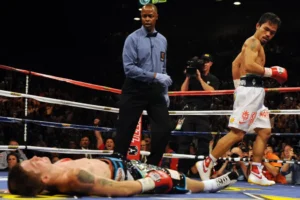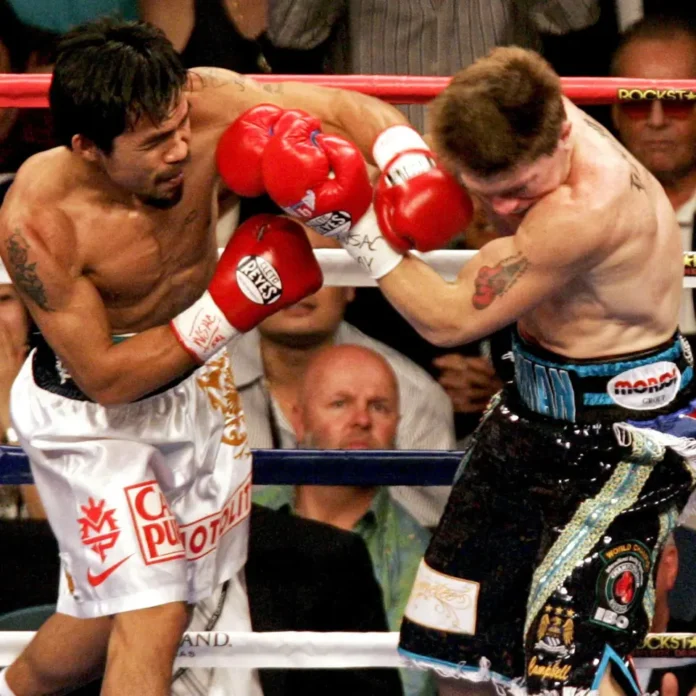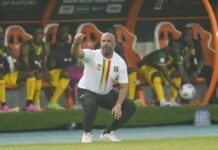The 68-year-old made his professional boxing debut as a teenager, but is most famous for steering Ricky ‘The Hitman’ Hatton through his glory years.
As he watches from ringside, he sees where the punches land, but also the innermost thoughts behind them.
“Fighters might say they don’t want to hurt their opponent, but let me tell you, when you’re in there, you do,” he says. “You absolutely do.
“You want to knock them out, you want to keep hitting them until they drop, so they’ll stop hitting you and you can get out of that hellhole.
“That’s the reality.”
It would be easy to presume that delivering a knockout punch is a moment of pure ecstasy, the kind of sensation footballers experience when scoring a goal.
But boxing is not football and knocking someone out is not like scoring a goal.
The knockout is brutal, final, irreversible – the fate all fighters dread and to which none are immune.
I have spent months examining that unique moment for a book, speaking to those on either end of sport’s most compelling, stark division of victor and vanquished.
What I found was surprising.
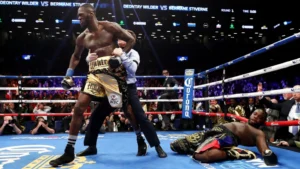
For some fighters their ability to deliver a knockout blow is a defining characteristic, part of their DNA.
David Haye and Deontay Wilder are two such men. Between them they have won 71 fights, 68 of them by knockout. This is how Haye describes the knockout moment.
“It’s a beautiful feeling,” he says. “We love the battle but to end the conflict in one fell swoop, the buzz… you can’t compete with that.
“I’ve never found any high that can come close to that.”
Wilder takes it a step further.
“You feel like a god. You feel very powerful,” says the American.
“It’s an indescribable feeling. The aftermath of it, it intensifies your feeling.”
For fighters like them, boxing is a religion and the knockout is their idol.
For others though, the feelings are more ambivalent.
“It’s a mixture of emotions and I don’t think until you wake up the next day you understand actually what you’ve done.”
That is how Carl Froch describes his feelings after knocking out George Groves in front of 80,000 people at Wembley Stadium in 2014, with what proved to be the final punch he threw as a professional boxer.
The build-up to the fight had been marked by animosity, with Groves – who had suffered a controversial loss in the pair’s first meeting six months previously – antagonising Froch at every opportunity.
But Froch’s satisfaction was professional, rather than personal, as a huge right hand crumpled Groves to the canvas.
“Your mind’s in a mad space,” he says. “But once it was stopped, I didn’t get too emotional. I was that much in the zone, it was just seek and destroy and when the knockout came I just kind of knew it was coming.”
If there is one emotion, it is relief. That is the most common emotion mentioned by fighters. Relief that it’s over, that it’s not them who now has to suffer the pain and humiliation of defeat, of failure.
It was exactly this feeling that Tony Bellew experienced when he knocked out Ilunga Makabu at Goodison Park to become WBC cruiserweight world champion.
“I just kneeled down and cried,” he says.
“Cried with relief at the fact that everything I’d been saying all these years had come true. It was just the greatest relief of my life.
“It just validated everything I’d been saying, that I was gonna be a world champion. It was the ultimate goal. I’d reached the ultimate goal.”
But sometimes that initial surge of relief morphs into something else. Sometimes the relief at seeing an opponent fall, knowing that the fight is over, quickly metamorphoses into a cold and icy fear, born of the realisation that the opponent isn’t moving.
Jamie Moore experienced this rising dread after knocking out Matthew Macklin in the 10th round of a full-blooded British light-middleweight title bout in 2006.
Macklin left the ring on a stretcher, but was released from a local hospital after precautionary checks. Moore cancelled his victory party to visit Macklin in hospital.
“This sport is beautiful and brutal in equal measure because you want to inflict pain on your opponent because that’s the only way you’re gonna win,” says Moore.
“But when you do it to that extent, then that scares you. Everyone wants to win but nobody wants to go to that extent.
“So you’re trying to find that middle ground. But when you push it to that end of it, it’s a scary feeling.”
Billy Graham was Macklin’s trainer that night. As he knows, that middle ground is a mirage.
It doesn’t exist. It can’t. Not in a sport like boxing.
Any empathy has to wait until the contest is over. But when it comes, it comes easily. Because every winner knows he is only ever a split-second away from swapping places.
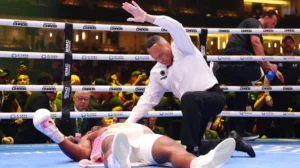
In early March, Francis Ngannou was knocked out by Anthony Joshua.
Ngannou’s legs folded underneath him, more than 19 stone of bone, sinew and muscle going limp. His limbs poured on to the canvas in languid fashion before settling in an almost perfect symmetry; legs stretched out straight in front of him, arms resting neatly at his side, his entire frame flat on its back.
Unconscious.
He told us later that he didn’t feel or remember a thing.
Some found that shocking but that’s how it is when a fighter gets knocked out cold. The violence of the blow to the brain is so great that there is no chance of a person being able to recall it.
Hatton was knocked out by Manny Pacquiao in equally brutal fashion in a Las Vegas super-fight in May 2009.
“I was knocked out cold and then after a couple of minutes you come around,” he says.
“You wake up and then you realise you’re in the ring and that you’ve been in a fight and you go back to the changing rooms after and then you talk to your coach and ask: ‘So what was it? What was the punch that caught me?’
“Then you say ‘yeah, yeah, I remember now, that’s right’ and it just takes you a while to absorb it again.”
Hatton’s fellow Mancunian Anthony Crolla had a similar experience against Ukrainian wizard Vasiliy Lomachenko in Los Angeles in 2019. With a minute to go in round four, Crolla was deposited face first on the canvas, knocked out.
“I didn’t realise until after it, just how bad it looked,” he says.
“In the dressing room my phone obviously was going mad, people concerned, wanting me to let them know I was OK.
“I feel absolutely fine and I say: ‘I don’t really understand all of this. I mean it’s really nice of people and everything but it’s not like it was a really bad knockout.’ And the room just went a bit quiet.
“I could see people thinking: ‘Ah, awkward, who’s gonna tell him?’ So I got my phone and watched it and thought: ‘Oh.’
“But it was mad because I could remember everything really clearly, how he set me up, the shot he hit me with.
“And I remembered being on the floor, face first, and I remember thinking I must look stupid, but I couldn’t move, it was like I’d been Tasered. I was talking to the referee, telling him I was fine and I genuinely was. I just couldn’t move for a little while.
“I was trying my hardest just to roll over but I’d face-planted and couldn’t. But that was the feeling; my senses were all there, I just couldn’t really move. I could remember it so clearly. And it didn’t hurt one bit.”
It’s an utterly fascinating description; so vivid and detailed as to be utterly convincing. But Crolla’s memory, like Hatton’s, isn’t real.
Dr Neil Scott, medical adviser to the British Boxing Board of Control and consultant head and neck surgeon elaborates.
“He may well have been knocked out and then the impact [of face planting] has woken him up,” Scott says.
“But he’s immediately exhibiting signs of a concussion, because he’s disorientated, he’s trying to start movement, trying to get his balance and get his legs to move but they just won’t because the nervous system at that stage is still in shock from the impact.
“There aren’t appropriate signals firing from his brain and down his spinal cord to get his limbs moving.
“He may look back and think that he was trying to get his legs up but I suspect that in that moment, if we’d had the benefit of looking at what was actually going on in his brain, even that wasn’t even going on.”
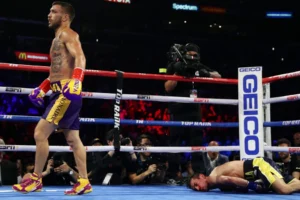
According to Scott, what Crolla experienced therefore, was more a lucid dream, conjured after the event, than a real memory,
Barry McGuigan painted a picture of the phenomenon in his autobiography, recalling a blow he received from the fist of hard-hitting Puerto Rican Juan Laporte in the ninth round of a points victory in 1985.
“When he hit me with that right, I was transported back to when I was a child and used to go to Mrs Keenan’s toy shop down the road,” McGuigan wrote.
“For a split second I thought I was in the toy shop again. I had the sense to grab Laporte, to try and allow my head to clear. It was a bit like when you’ve been walking along in the rain and get into your car: the windscreen steams up, you put on the fan to clear and it takes a bit of time before you can properly see out again.”
As an undefeated rising star with 18 wins to his name, Amir Khan was flattened twice and counted out in just 54 seconds against Breidis Prescott. On each visit to the canvas he felt enveloped in thick, swirling fog, while trying to get his bearings.
“It’s the worst place to be,” he says.
“It’s like a jigsaw that has just gone smash, into pieces, and you’re trying to put it back together as quick as possible. That’s what it is like.
“You’re hearing so many different voices from different people, you’re hearing different voices from outside, voices that you recognise, and the referee counting as well and you’re thinking: ‘Who am I listening to? What should I do?’
“It’s a very tough position to be in.”
Nobody described this hideous out-of-body experience better than Muhammad Ali. The Greatest described being in that state of not knowing where you are as being on the threshold of the ‘Near Room’.
Boxing writer George Plimpton related how Ali described the Near Room to him in his classic book Shadow Box:
“A place to which, when he got in trouble in the ring, he imagined the door swung half open and inside he could see neon, orange and green lights blinking, and bats blowing trumpets and alligators playing trombones, and where he could see snakes screaming. Weird masks and actors’ clothes hung on the wall, and if he stepped across the sill and reached for them, he knew that he was committing himself to his own destruction.”
The Near Room calls to hurt fighters, woos them, but it must be resisted.
Appealing though it might appear to be in that strange twilight of semi-consciousness, a fighter has to refuse the temptation to enter that room, to go under, until, as McGuigan described it, the windscreen clears and “you can see properly out again”, at which point the Near Room will recede into the distance.
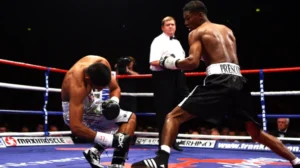
But there are some knockouts that cannot be resisted and the aftermath can be horrific.
The strains of a rendition of Rule Britannia from his travelling army of fans had just died away when a crunching left hand from Pacquiao floored Hatton.
It took him a good couple of minutes to get back to his feet. The after-effects lasted a lot longer. Hatton suffered terribly with depression in the wake of his knockout – he was suicidal and attempted to kill himself ‘several times’.
“People would say: ‘What’s he got to be depressed about? Yeah he got beat by Pacquiao, but, look, he’s got a nice house, he’s got a nice car, he’s got this, he’s got that, what does he need to be worried about?’ But they don’t realise the state it leaves you in,” says Hatton.
“When you’re a fighter and a winner, you have to have that belief in yourself and that attitude that no-one can beat you, that you’re the best.
“If you’re a proud, proud man, a proud boxing champion, you know, it doesn’t matter what you put in the bank and how big your house is, it messes you up a bit.”
The emphatic manner of the Pacquiao loss cut deep. It was crippling. That is what the knockout can do, the effect it can have. It can steal a vital part of the defeated fighter.
Physiologically what is happening in that moment is easier to explain.
“It varies from person to person. But essentially an impact causes a shift or movement of the brain within the skull,” says Scott.
“The jolting force totally disrupts the nerve signals within the head, and the response is that the system momentarily almost shuts down.
“It’s like a protective kind of mechanism, resulting in a temporary loss of consciousness.
“Anyone can be knocked out, it just depends on how difficult that process is going to be.”
There are plenty of professionals who’ve never been knocked out. American legend Marvin Hagler survived some vicious bouts, notably his 1985 war with Thomas Hearns, before retiring without a losing KO on his record.
But in Scott’s estimation, such a record is, at least partly, down to luck.
“They haven’t been exposed to the level of force or that exact ‘everything lining up’ moment – the ‘Swiss cheese effect’, external where all the factors come together – that would lead to that knockout for them,” he says.
A knockout will most often occur through “getting caught with a shot that you aren’t fully prepared for” and because you’re not prepared for it “you haven’t got that brace system set up”.
When a punch lands on an unprepared opponent, the force transmits through the skull of a fighter more effectively, causing even greater movement of the brain and a correspondingly slimmer chance the recipient has of staying conscious.
In boxing we often refer to a fighter’s ‘chin’, referencing their ability to take a punch and not get knocked out.
It is an ability that is hard to define.
“We can describe fighters as having a strong chin but they have a lot of other factors counting for them,” says Scott.
“Maybe have particularly strong neck muscles or they may just not be as prone physiologically to a concussion.
“If you get a firm hit on the chin, the nature of the bottom jaw, the mandible, is that it’s a U-shaped bone essentially. The force will be transmitted straight around it, up to your jaw joint and straight to the base of your skull. And the force then dissipates.
“If that happens to you or me, there’s a high chance we would break our jaw joints at the point of impact.
“However, in an elite athlete who has strengthened their neck and back and their upper torso, the response is different. The force is better dissipated, because of the reinforcement around the skull.”
A knockout punch reverberates far beyond the ring though
